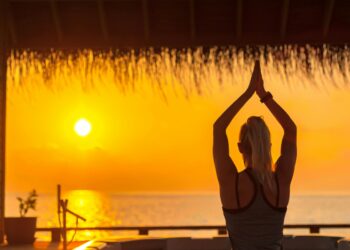Body relaxation is one of the essential things in our lives, so we have to find the correct method to fulfill it. This article will tell you the best exercise schedule for a full-body workout at home. The most important part is to find the right exercises and workouts in which we are interested. You will need exercises that do not bore you.
Best home workout schedule for body relaxation
I think that the best schedule for a home workout is that you can stick to and enjoy. It may be challenging to find time to workout at home if you have a hectic schedule. I suggest choosing a few exercises that will help you relax your body and mind.
One of the best exercises for relaxation is yoga. Yoga is an ancient activity that helps you enhance your physical fitness and general health and well-being. It has been shown to aid in the relaxation of both the mind and the body. But this should do with proper guidelines.
There are several forms of workouts that might assist you in reducing stress in your life, such as meditation, tai chi, qigong, etc. These exercises are great ways to lower your blood pressure, improve your overall health, and reduce stress levels in your life. You can also try other types of activities, such as massage therapy or acupuncture treatments. It may also be very helpful in reducing stress in your life!
I suggest you try out some different exercises until you find one that works best for you because everyone’s body responds differently to other workouts!
To begin with, you need to know that everyone has their fitness level and goals. The most common goal among people is weight loss and fat burning. This can be achieved by exercising regularly, eating healthy foods, and drinking enough water daily. Make your workout schedule 3 steps essential to add to your health and relaxed body: warm-up, workout, and cool down and instruction after the workout.
How do you start a workout plan with a Warm-up?
Warm-up is one of the best parts of your workout schedule. It would be best to start with a warm-up routine before starting any workout session to avoid injuring yourself. After warming up, you can proceed with your chosen exercises without any problems.
Warm-up Routine Before Workout
Full-body workout schedule after the Warm-up
A full-body workout consists of exercises that target all major muscle groups in your body, including arms, chest, back, shoulders, legs, and abs. A good example of a full-body workout would be squats (quadriceps), bench press (chest), deadlift (hamstrings), lat pulldown (lats), bent over row (upper back), side lateral raise (deltoids), and leg press (quads). These are some of the most important muscles in our bodies that need to be worked out regularly to stay fit and healthy! Below we provide a workout schedule for beginners to start their daily workout.
Types of exercises
Cardio: 30 minutes of walking, jogging, or cycling 5 days a week.
Strength training: 2 days per week, with 1 day focusing on lifting weights and 1 day focusing on bodyweight exercises like push-ups and squats.
Tai chi: Tai chi is another form of martial arts that involves slow movements with deep breathing while standing still or moving very slowly around the room while holding certain poses as long as possible until they become
20 min full-body workout for total beginners (No Equipment)
What should I do after the workout?
You are approaching the end of your workout and mentally going through the motions of all you need to accomplish as soon as you step off the treadmill. However, completing your training regimen does not mean that you have reached your fitness goals. A few more measures need to be taken before reaching good health. Here are a few pointers on what to do after your post-exercise routine after you’ve finished your workout.
- Drink up water- The water your body loses while you work out. Muscle elasticity and strength can be improved by replenishing your body’s water supply.
- Cooldown -Your temperature increases when you exercise, so use your treadmill’s cool-down mode to help you cool down after a strenuous workout.
- Stretch– You can increase Stretch by Warm-up.
- Change your clothing – Yeast, fungus, bacteria, and other microorganisms thrive in wet environments, such as sweat-soaked training gear. As a result, it might cause breakouts or infections on the skin.
- Take a cool shower– Set the temperature of your shower to be lower than you usually are. Taking a chilly shower after a workout is a great way to speed up your recovery and reduce muscle aches and pains.
- Let your body short daybreak to recover.
- Take the right snack and maintain a diet plan.
Suggested Relax Log: How to relax my mind with meditation
How to avoid injuries during your workout?

This is the first rule to keep in mind. If you are a woman over 55, talk to your doctor before beginning an exercise regimen. Afterward, you’ll know if you’re physically fit enough to engage in physical activity. A man over the age of 45, or a man with any medical issue, can expect the same results.
Anyone can get injured during an exercise, regardless of their degree of fitness or experience. Even the simplest tasks, such as walking, might result in an injury. However, taking a few safety precautions during your workout can significantly reduce your risk of injury. Avoiding injuries when exercising can be as simple as following a few simple guidelines.
Here are a few tips to help you prevent being injured during your workout:
- Don’t forget Warm-up before starting your workout.
- Practice cool-down to get your heart rate back to normal. You can cool down by walking for five to ten minutes after exercising.
- Increase Stretch – Before and after your workout, perform dynamic stretching. Flexibility will be improved as a result of this.
- Start slowly new workout program.
- Avoid overusing a single group of muscles.
- Know and pay attention to your trouble spots before the workout.
- Do not forget to drink water yourself throughout your workout.
- Advise by an experienced trainer.
- Select the right dress.
- Take a day or two off every week to rest.
Benefits of relaxation my whole body
If you want to relax your whole body at once, it’s best to pick one muscle group and focus on stretching out those muscles. Stretch them lightly until they feel relaxed, then hold the stretch for 10 seconds before repeating for about 5 minutes total.
You can begin with simple stretching and daily walks to keep moving. You could also try one of the exercises mentioned above to release tension in your muscles. There are several exercise techniques you can easily practice at home that will help you relax your whole body and provide you with a stronger sense of well-being.
The three activities which will benefit you and relax your whole body are walking, swimming, and cycling. Walking will help strengthen and stretch muscle groups throughout your body while giving you time to focus on things other than work. Swimming and cycling can provide a low-stress workout for your cardiovascular system and help with weight control.
“ Take a breath well & find your relaxation“


